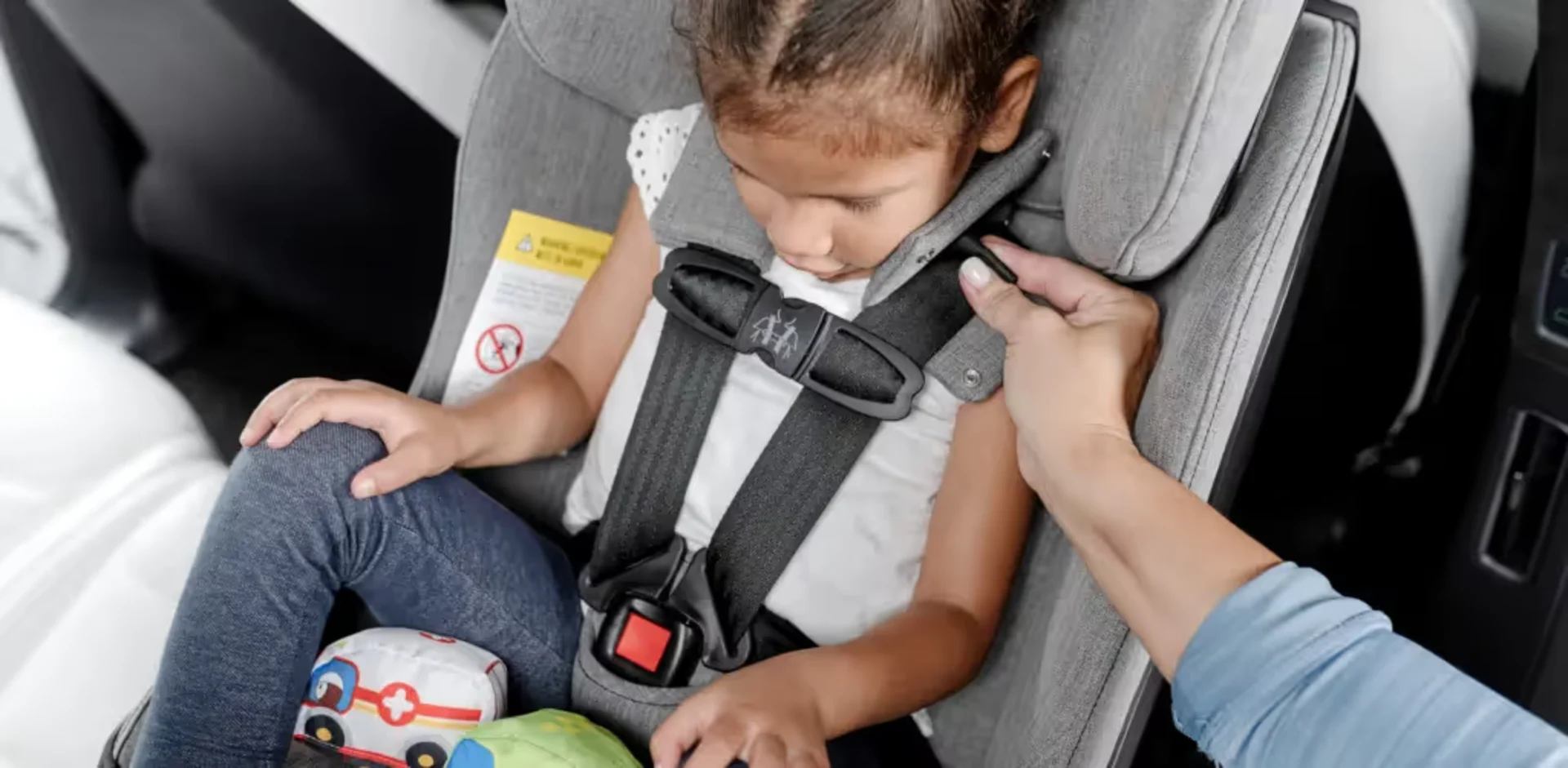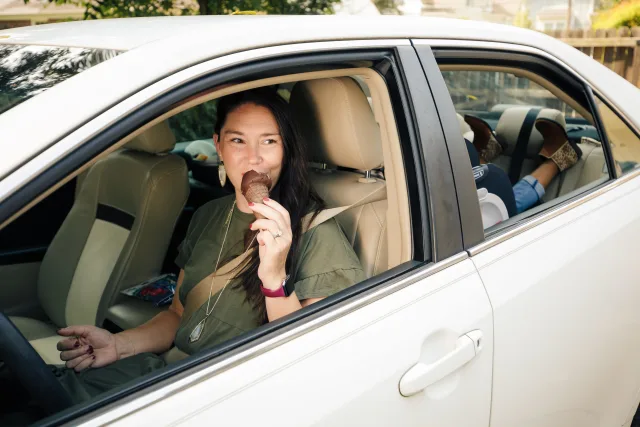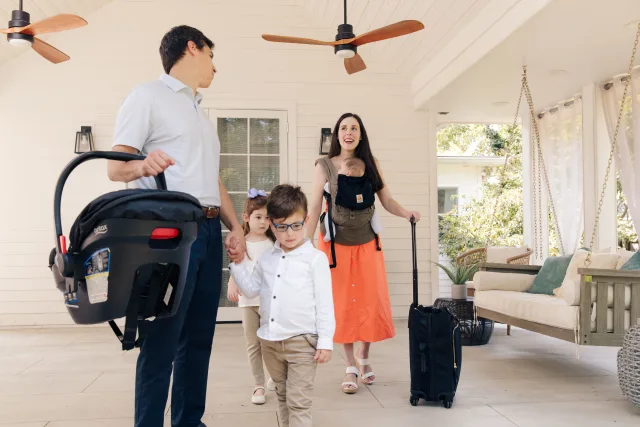Car seats, also known as child safety seats, are one of the most important pieces of baby gear we buy for our little ones. With the amount of time families spend driving, it's essential to avoid every possible installation mistake and ensure your car seat is being used as intended. Not only are the roads unpredictable, but according to the National Highway Traffic Administration car accidents are a leading cause of death and serious injury for both adults and children.
So how can you ensure your child is as safe as possible? Your first instinct might be to buy the most expensive car seat out there and hope for the best. But, really, that’s not the key to your child’s safety. Instead, the key is to ensure that your car seat is installed correctly. And that you’re utilizing your car seat properly. From buckling up to bundling up, using your car seat properly is the best way to protect your precious backseat riders and get the most out of your car seat purchase.
View this post on Instagram
A post shared by Michelle Pratt, CPST (@safeintheseat)
Test your car seat knowledge! Can you spot the 7 things wrong with the installation and harnessing of this forward-facing car seat? In this video, I’ll show you the most common errors we see and how to fix them to keep your forward-facing rider safe in their seat!
On our blog, you will find a plethora of information on car seat safety, installation, care, and more. But still, there are some common car seat mistakes that parents might not even realize they are making! So today, we are sharing the top 10 most common car seat mistakes to help parents avoid these serious safety risks. And have peace of mind that their children are safe in their seats. Let’s get into it!
10 Common Car Seat Mistakes
Mistake One: Front-Face Too Early
Many states have motor vehicle laws that state that children cannot front-face until they’re 2 years old. Because of this, many parents assume that 2 years is the time you automatically flip to a front-facing car seat. Although legal, this is not the best way to keep your child safe in their seat. Your child is less likely to be killed or seriously injured in a crash if they’re in a rear-facing car seat. So keep them in a rear-facing seat as long as possible until they’ve reached the max weight or height limit on their seats. Learn more about rear vs. forward facing here.
View this post on Instagram
A post shared by Michelle Pratt, CPST (@safeintheseat)
View this post on Instagram
A post shared by Michelle Pratt, CPST (@safeintheseat)
Mistake Two: Low Chest Clip
The chest clip has a very important job: it keeps the harness straps in the right spot on your child’s shoulders so that the harness straps can do their job if a crash happens. If the chest clip is too low, then the harness straps might slide off your child’s shoulders. If the harness isn’t in the right spot, then your child’s body will be able to move way too much during a crash. And in an extreme case, their entire body could even be ejected from their car seat! So if this sounds scary, that’s because it is. Line that chest clip up with your child’s armpits so that the harness stays in the right position!
We will note here that chest clips are a really misunderstood car seat feature: you might hear people tell you that the chest clip is what restrains the child. Or that a low chest clip will puncture your child’s abdominal organs in a crash. These scary myths aren’t true!
As we said, the chest clip is a positioning device. During a crash, it may break open or slide down the harness straps due to the amount of force — and all of this is A-okay. Because by the time the crash occurs, it’s already done its job! And, because the chest clip often moves or breaks during a crash, there is no need to worry that it’ll cause your child any injuries on its own. The risk of a low chest clip is a poorly positioned harness, which CAN cause injuries. But the chest clip itself won’t hurt your child in a crash!
Mistake Three: No Top Tether
This common mistake often takes place during installation. When you flip your child around from rear-facing to forward-facing, there is a required top tether that keeps the seat from tipping forward in a crash. Because this part of the car seat is not usually utilized during the rear-facing installation, parents often forget to attach it during that second stage of the car seat’s journey. Without the top tether, the top part of your child’s forward-facing car seat will be able to fly forward in a crash, and this can contribute to head injuries. The top tether is an easy and powerful way to reduce this risk by a lot! As you transition to the forward-facing stage, keep this common mistake in mind and ensure proper installation.
View this post on Instagram
A post shared by Michelle Pratt, CPST (@safeintheseat)
If your child is in a forward-facing car seat with a harness, it has a top tether anchor. USE IT!
When a car seat is tightly installed, and the top tether anchor is in proper use, it limits a forward-facing car seat from tipping forward by 4-6+ inches. By limiting that movement, you are protecting your child’s head from hitting the vehicle seat in front of it, the door or console, or a fellow passenger in a car crash. A correct and tight installation plus a top tether truly is a life-saving combination!
Mistake Four: One Inch Rule
Though there is both a height and weight limit for various car seat modes, these are not the only ways in which your child can outgrow their seat. Torso height matters as well. A child could be below the height limit. However, if much of their height is in their torso, they might be too tall for their rear-facing seat. When they’re rear-facing, your child needs to be one inch below the top of the car seat shell or headrest so that the car seat can do its job and protect their noggin!
The one-inch rule only applies to rear-facing seats.
View this post on Instagram
A post shared by Michelle Pratt, CPST (@safeintheseat)
For forward-facing harnessed seats or boosters, the rule is different: your child’s head can extend over the top of their car seat headrest. As long as their ears are below the top (and, of course, their harness is properly fitted!). Even adults should make sure they have head support to the tops of their ears. This helps protect against whiplash injuries!
This is such a great example of why torso height matters so much when choosing a car seat! Kids SIT in seats so while the standing height limit is a factor, it’s not the most important one! When purchasing a car seat, knowing your child’s body type and the car seat’s harness height is a really great indicator of how long the seat will last for you. I had no idea my son had a long torso. And certainly didn’t know it was something I should consider when choosing a car seat!
P.S. Note the marketing of car seats—they never talk about this. They lure your attention with materials, weight limits, narrow to fit multiple, etc. Don’t forget to investigate the harness height limits too, especially if your kid has a long torso! In our Car Seat Buying Kits, we teach you how to look at your child’s proportions, create a growth trajectory, and then apply that information to the relevant seat stats to choose the car seat that is the best and longest-lasting for your specific child. We provide all those specifics and every other detail you need to know too in our database of recommended seats!
View this post on Instagram
A post shared by Michelle Pratt, CPST (@safeintheseat)
Mistake Five: Shoulder Strap Placement
Improper shoulder strap placement is another car seat mistake that happens because of the many changes throughout your child’s car seat journey. When your child is rear-facing in an infant car seat or a convertible car seat, the harness straps should come from at or just below the shoulders. You don’t want your rear-facing child’s harness straps above their shoulders, even a smidge! When the child is front-facing, they come from just above. If your child has recently changed positions or you weren’t aware of this necessary adjustment, double-check the placement before your next car ride!
View this post on Instagram
A post shared by Michelle | Car Seat Safety (@safeintheseat)
PS – Don’t forget the crotch buckle as well!
Mistake Six: Latch Install Past Limit
When you first installed your car seat, there were two options for installation: using the latch system or the seat belt path. Lots of parents find the latch install easier to use or believe that it’s safer (spoiler alert: it’s not!). However, many don’t realize there is a weight limit on the latch system.
The max weight is usually 65 lbs, which includes the weight of your car seat. The good news is your car seat manufacturer knows how much the car seat weighs. And they’ve done the math for you! So there will be a weight limit on your car seat for the latch installation method — this is the child’s weight only. (The only exception is for infant car seats, which don’t have latch weight limits. Because the whole seat will be outgrown before your baby reaches that point!) If you want to set it and forget it, go with the seat belt install initially.
Mistake Seven: Too Much Seat Movement
If a car seat is installed properly, it shouldn’t move side to side more than one inch when you check it with a firm handshake at the belt path. Many parents, even parents who have prioritized car seat safety, accidentally install the car seat in a way that allows too much movement. Proper installation is tough, so we recommend you see a certified child passenger safety technician! They are experts in car seat safety. And they can help you in person or virtually with the whole car seat installation process.
View this post on Instagram
A post shared by Michelle Pratt, CPST (@safeintheseat)
You can find a CPST near you here. Or you can schedule a consultation with one of our very own CPSTs, here! We join you virtually, which is super handy for a busy mom like you. Oh, and if you were just planning on stopping at a fire station, don’t! It’s a myth that all fire departments have CPSTs. Make sure you’re speaking to a certified professional.
Mistake Eight: Puffy Coats
It’s getting colder out there. And each winter, we’re flooded with images of kids in puffy coats stuffed into their car seats. This is a big no-no! Puffy winter coats compress in a crash. This means when you tighten your child’s harness straps around their coats, it’s not really tight at all. There’s actually tons of space between your kiddo and their straps. And this leads to a whole lot more movement than we want.
Of course, this is not safe at all and increases your child’s risk of injury or death in a crash. For tips on how to bundle up properly, check out this post. We give you great product recommendations and break down the dos and don’ts of cold-weather clothes for car seats.
Put your child’s coat to the test and learn how to keep them warm in their seat in our Winter Safety Download.
Mistake Nine: Aftermarket Products
If the item did not come with your car seat or come from the car seat manufacturer, do not put it on your car seat. Aftermarket products like seat covers, attachable toys, strap padding, vehicle seat protectors, and headrests are not safe and not approved for use with your car seat.
View this post on Instagram
A post shared by Michelle Pratt, CPST (@safeintheseat)
As long as the car seat is appropriate for your child’s age, height, and weight, you shouldn’t need any additional accessories.
View this post on Instagram
A post shared by Michelle Pratt, CPST (@safeintheseat)
Mistake Ten: No Booster
How long should your child be in a booster seat? Longer than many people think! There is actually a 5-step test to confirm your child is ready. Normally, they’re not ready until about 12.
View this post on Instagram
A post shared by Michelle Pratt, CPST (@safeintheseat)
Not only do we see tons of younger kids riding with no boosters at all, but we see kids in the booster phase sitting in the front seat. No way! Take your child all the way through their car seat journey by keeping them safely in a booster seat until they pass the 5-step test.
View this post on Instagram
A post shared by Michelle | Car Seat Safety (@safeintheseat)
Take the guesswork out of graduating from one seat to the next with our Car Seat Progression eBook.
Keep your child safe by avoiding these 10 common car seat mistakes.
Be sure to check out our YouTube Video The Most Common Car Seat Mistakes. In this video, I’ll show you the most common errors we see and how to fix them to keep your rear-facing rider safe in their seat!
Check out this video for the top ten things to keep your baby safe in and out of the seat. From what your baby wears, to stroller safety to how to put your baby in a shopping cart I’ll walk you through what you need to know for your baby and car seat safety.
Looking to dive deeper? Check out our Convertible Course to learn all you need to know from installation to harnessing and trouble-shooting during your kiddo’s longest seat stage.
Using a car seat isn’t as easy as 1-2-3. It’s not hard either. But you need to have the proper know-how to get the right fit every time. Knowing your child is safely in their car seat will give you peace of mind and confidence that you’re doing all you can to protect your little one. Safe in the Seat is here to help!






